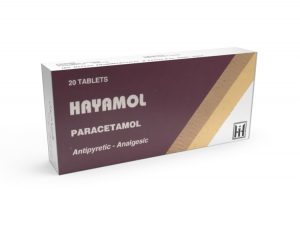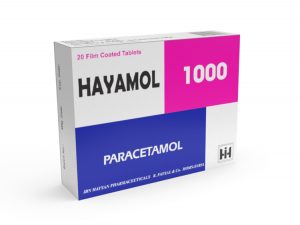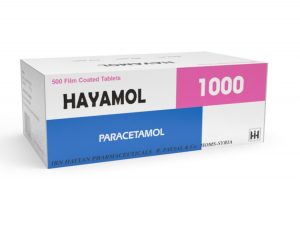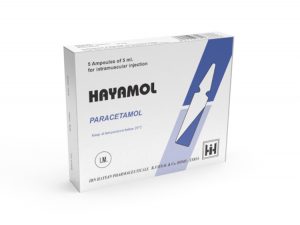Packing :1 Vial - 100 ml.
Form : Liq.Vial
Theraputic Categories : Analgesics
Indications : Non-opioid analgesic and Antipyretic
Composition :Paracetamol 1g. / vial
Composition: each vial 100 ml contains paracetamol 1000 mg.
Pharmacological properties:
Paracetamol, a para-aminophenol derivative, has analgesic and antipyretic properties and weak anti-inflammatory activity.
The precise mechanism of the analgesic and antipyretic properties of paracetamol has yet to be established; it may involve central and peripheral actions.
HAYAMOL VIAL, solution for infusion provides onset of pain relief within 5 to 10 minutes after the start of administration. The peak analgesic effect is obtained in 1 hour and the duration of this effect is usually 4 to 6 hours.
HAYAMOL VIAL reduces fever within 30 minutes after the start of administration with a duration of the antipyretic effect of at least 6 hours.
Indications:
HAYAMOL VIAL is indicated for the relief of mild to moderate pain and the reduction of fever where an intravenous route of administration is considered clinically necessary.
contraindications:
hypersensitivity to paracetamol or to propacetamol hydrochloride or to any of the excipients, severe hepatocellular insufficiency, patients with hepatic failure.
precautions:
It is recommended to use a suitable analgesic oral treatment as soon as this administration route is possible.
In order to avoid the risk of overdose; check that other medicines administered do not contain paracetamol.
Doses higher than the recommended entail a risk of very serious liver damage. Clinical symptoms and signs of liver damage are usually seen first after two days with a maximum usually after 4 to 6 days. Treatment with antidote should be given as soon as possible.
HAYAMOL VIAL should be used with caution in cases of:
hepatocellular insufficiency, severe renal insufficiency (creatinine clearance ≤30 mL/min) , Glucose 6 Phosphate Dehydrogenase (G6PD) deficiency (may lead to haemolytic anaemia), chronic alcoholism, excessive alcohol intake, anorexia, bulimia or cachexia, chronic malnutrition (low reserves of hepatic glutathione), dehydration, hypovolemia.
The total dose of paracetamol should not exceed 4 g per day. It is important to consider the contribution of all paracetamol containing medications, including non-prescription, oral or PR forms of the drug to this total daily paracetamol dose prior to administering HAYAMOL VIAL .
Patients with hepatic insufficiency, chronic alcoholism, chronic malnutrition or dehydration may be at a higher risk of liver damage following administration of HAYAMOL VIAL .
Drug interactions:
Probenecid causes an almost 2-fold reduction in clearance of paracetamol by inhibiting its conjugation with glucuronic acid. A reduction of the paracetamol dose should be considered for concomitant treatment with probenecid.
Caution should be paid to the concomitant intake of enzyme-inducing agents. These substances include but are not limited to barbiturates, isoniazid, anticoagulants, zidovudine, amoxicillin + clavulanic acid, and ethanol.
Concomitant use of paracetamol (4 g per day for at least 4 days) with oral anticoagulants may lead to slight variations of INR values. In this case, increased monitoring of INR values should be conducted during the period of concomitant use as well as for one week after paracetamol treatment has been discontinued.
Phenytoin administered concomitantly may result in decreased effectiveness and an increased risk of hepatotoxicity. Patients receiving phenytoin therapy should avoid large and/or chronic doses of paracetamol. Patients should be monitored for evidence of hepatotoxicity.
Use in Pregnancy and Lactation:
Pregnancy Category (Category A):
Paracetamol has been taken by a large number of pregnant women and women of childbearing age without any proven increase in the frequency of malformations or other direct or indirect harmful effects on the fetus having been observed.
Lactation: HAYAMOL vial may be used in breast-feeding women.
Adverse reactions:
Skin rashes, leucopenia, thrombocytopenia, Dizziness, Nausea, Vomiting, Anemia, SGPT increase, injection site pain.
Dosage and Administration:
Intravenous route
HAYAMOL VIAL should not be mixed with other medicinal products.
Adults:
The recommended dose in patients weighing more than 50kg is:
Paracetamol l g per administration, i.e. one 100 mL vial, up to four times a day.
The minimum interval between each administration must be 4 hours in patients without hepatic or renal impairment. In patients with renal and/or hepatic impairment the minimum interval between doses must not be less than 6 hours.
The maximum daily dose from all sources of paracetamol must not exceed 4 g for patients weighing more than 50kg and 60mg/kg for patients less than 50kg but more than 33 kg (without exceeding 3g).
children weighing up to 33 kg (about 11 years old):
Paracetamol 15 mg/kg per administration, i.e. 1.5 mL of solution per kg, up to four times a day.
The minimum interval between each administration must be 6 hours.
The maximum daily dose must not exceed 60 mg/kg.
Term newborn infants, infants, toddlers and children weighing less than 10kg (up to approximately 1 year old): it is recommended to reduce the dosage by half, i.e. 7.5 mg/kg paracetamol per administration, without exceeding 4 administrations per day.
There is limited data on the use of HAYAMOL VIAL in neonates and infants <6 months of age
Hepatic Impairment
In patients with chronic or active hepatic disease, especially those with hepatocelluar insufficiency, chronic alcoholism, chronic malnutrition, and dehydration the dose should not exceed 3g/day.
Method of administration
The paracetamol solution is administered as a 15-minute intravenous infusion, it contains no antimicrobial agent, and is for single use in one patient only.
HAYAMOL vial can also be diluted in a 0.9% sodium chloride or 5 % glucose solution up to one tenth. In this case, use the diluted solution within the hour following its preparation (infusion time included).
As for all solutions for infusion presented in glass vials., it should be remembered that close monitoring is needed notably at the end of the infusion, regardless of the administration rout. This monitoring at the end of the perfusion applies particularly for central rout infusion, in order to avoid air embolism.
Overdosage:
There is a risk of poisoning, particularly in elderly subjects, in young children, in patients with liver disease, in cases of chronic alcoholism, in patients with chronic malnutrition and in patients receiving enzyme inducers. Poisoning may be fatal in these cases. Acute overdose with paracetamol may also lead to acute renal tubular necrosis.
Symptoms generally appear within the first 24 hours and comprise of nausea, vomiting, anorexia, pallor and abdominal pain. Overdose, 7.5 g or more of paracetamol in a single administration in adults or 140 mg/kg of body weight in a single administration in children, causes cytolytic hepatitis likely to induce complete and irreversible hepatic necrosis
Treatment:
Immediate hospitalization.
Before beginning treatment, take blood for plasma paracetamol assay, as soon as possible after the overdose.
Treatment of paracetamol overdose may include the antidote N-acetyl cysteine (NAC) by the IV or oral route.
Symptomatic treatment.
Hepatic tests must be carried out at the beginning of treatment and repeated every 24 hours.
Packing: 1 vial 100 ml contains 1 gram paracetamol.
Storage: Store below 30°C. Do not refrigerate or freeze.













